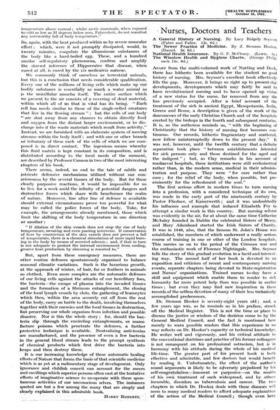• Nurses, Doctors and Teachers
A General History of Nursing. By Lucy Ridgely Berner. (Faber and Faber. 12s. 6d. ) The Newer Practice of Medicine. By J. Stenson Hooker. (Daniel. 3s. Bd.) APART from the multi-volumed work of Nutting and Dock, there has hitherto been available for the student no good history of nursing. Mrs. Seymer's excellent book effectively fills the gap. Moreover, it brings us right up to present-day developments, developments which may fairly be said to have revolutionized nursing and to have opened up vistas
of a new status for the nurse, far removed from any she has previously - occupied. After a -brief account of the treatment of the sick in ancient Egypt, Mesopotamia, India, Greece and Rome, a description is given of the work of the deaconesses of the early Christian Church and of the hospitals erected by the bishops in the fourth and subsequent centuries. It is, as the authoress reminds us, " with the beginning of Christianity that the history of nursing first becomes con- . . tuitions. Our records, hitherto fragmentary and scattered, now follow uninterruptedly down to the present day." It was not, however, until the twelfth century that a definite separation took place " between establishments intended for sick persons only and those destined for the aged and the indigent " ; but, as Clay remarks in his account of mediaeval hospitals, these institutions were still ecclesiastical rather than, in the modern sense, medical in their adminis- tration and purpose. They were " for care rather than cure ; for the relief of the body, when possible, but pre- eminently for the refreshment of the soul."
The first serious effort in modem times to turn nursing into a profession, with a considered technique of its own, was made in the early part of the nineteenth century by Pastor Fliedner, of Kaiserwerth ; and it was undoubtedly his influence and example that induced Elizabeth Fry to attempt a similar work in this country. But nursing reform was evidently in the air, for at about the same time Catherine McAuley founded in Dublin the celebrated Sisters of Mercy, and Mary Aikenhead started the Irish Sisters of Charity.
It was in 1848, also, that the famous St. John's House was established, the members of which underwent a really serious course of training in one or other of the London hospitals. This carries us on to the period of the Crimean war and the enthusiastic work of Florence Nightingale. Mrs. Seymer tells the story of this gradual evolution in a lucid and interest- ing way. The second half of her book is devoted to an exposition and criticism of recent and contemporary nursing events, separate chapters being devoted to State-registration and Nurses' organizations. Trained nurses to-day have a skill and equipment which enable them to render to sick
humanity far more potent help than was possible in earlier times ; but ..even they may find new inspiration in these records of the selfless devotion of many -of their less techniCally accomplished predecessors.
Dr. Stenson Hooker is seventy-eight years old ; and, a few years ago. was, as he reminds us in his preface, struck
off the Medical Register. This is not the time or place to discuss the justice or wisdom of the decision come to by the General Medical Council, and the fact is mentioned here merely to warn possible readers that this experience in no way reflects on Dr. Hooker's capacity or technical knowledge.
He writes well and vigorously, and his critical attitude to the conventional doctrines and practice of his former colleagues
is not consequent . on his professional ostracism, but is in harmony with his attitude during the whole of his medical life-time. The greater part of his present book is both effective and admirable, and few doctors but would benefit by reading it. Unfortunately, the effect of the author's
sound arguments is likely to be aversely prejudiced by his self-congratulationinnocent or purposive—on the results of his Own treatment of such widespread, and by others incurable, disorders as tuberculosis and cancer. The two chapters in which Dr. Hooker deals with these diseases will seem to many medical readers to afford adequate' explanation of the action of the Medical Council ; though even here will be found inany excellent and original suggestions. " My ideal sanatorium- would be equipped with *a -good stable of
horses ; " you have a garden or even a- yard, get a swing put up and use it as much as .possible." A book to be read, but not by the uncritical.
Dr. McCleary's book is of a very different order. As one of the senior Medical officers of the Ministry of Health, he is , - - in a position to describe with authority the system of National Health Insurance with the administration of which he is specially concerned. - His bOok is informing and accurate as to details, but it fails to do justice to the criticisms which have been levelled both at the conception and at the adminis- tration of our Health Insurance Acts. It has indeed a sug- gestion of the complacency which characterizes the annual medical reports of the Ministry ; hut, if allowance be made for ihls, those who are interested will find in Dr. McCleary's work a statement of the chief facts relating to National Insurance considered as a measure of Public Health. - It is a history as well as an exposition. .
The WisislOw Health and Hygiene Charts, which Messrs. Philip have prepared for class-room use; should help thOse who teazh elementary anatomy and physiology to children whose attention is apt to wander in the absence of something tangible or visible to which the explanations may attach them-Nelves:, The leaflets by Professor Mottram, which accompany the plates, summarize the relevant facts in a convenient form. The brightly coloured charts, thirteen in number, measure each 44 by 32 inches, and are mounted on linen.



























































 Previous page
Previous page